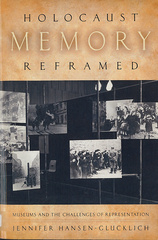Holocaust Icons
Symbolizing the Shoah in History and Memory
Rutgers University Press
The Holocaust has bequeathed to contemporary society a cultural lexicon of intensely powerful symbols, a vocabulary of remembrance that we draw on to comprehend the otherwise incomprehensible horror of the Shoah. Engagingly written and illustrated with more than forty black-and-white images, Holocaust Icons probes the history and memory of four of these symbolic relics left in the Holocaust’s wake.
Jewish studies scholar Oren Stier offers in this volume new insight into symbols and the symbol-making process, as he traces the lives and afterlives of certain remnants of the Holocaust and their ongoing impact. Stier focuses in particular on four icons: the railway cars that carried Jews to their deaths, symbolizing the mechanics of murder; the Arbeit Macht Frei (“work makes you free”) sign over the entrance to Auschwitz, pointing to the insidious logic of the camp system; the number six million that represents an approximation of the number of Jews killed as well as mass murder more generally; and the persona of Anne Frank, associated with victimization. Stier shows how and why these icons—an object, a phrase, a number, and a person—have come to stand in for the Holocaust: where they came from and how they have been used and reproduced; how they are presently at risk from a variety of threats such as commodification; and what the future holds for the memory of the Shoah.
In illuminating these icons of the Holocaust, Stier offers valuable new perspective on one of the defining events of the twentieth century. He helps readers understand not only the Holocaust but also the profound nature of historical memory itself.
Jewish studies scholar Oren Stier offers in this volume new insight into symbols and the symbol-making process, as he traces the lives and afterlives of certain remnants of the Holocaust and their ongoing impact. Stier focuses in particular on four icons: the railway cars that carried Jews to their deaths, symbolizing the mechanics of murder; the Arbeit Macht Frei (“work makes you free”) sign over the entrance to Auschwitz, pointing to the insidious logic of the camp system; the number six million that represents an approximation of the number of Jews killed as well as mass murder more generally; and the persona of Anne Frank, associated with victimization. Stier shows how and why these icons—an object, a phrase, a number, and a person—have come to stand in for the Holocaust: where they came from and how they have been used and reproduced; how they are presently at risk from a variety of threats such as commodification; and what the future holds for the memory of the Shoah.
In illuminating these icons of the Holocaust, Stier offers valuable new perspective on one of the defining events of the twentieth century. He helps readers understand not only the Holocaust but also the profound nature of historical memory itself.
Stier offers an interdisciplinary approach to the question of how and in what ways memory becomes history, focusing on the Shoah. Great for students, scholars, and lay audiences.
Stier's work is stimulating in its erudition, especially its critical eclecticism.
Oren Stier has thought deeply, sensitively, and intelligently about the Holocaust and its memorialization. His profound exploration is shaped by literature and history, art and theology, mythology and cultural history. His writing is unfailingly interesting.
This thoughtful, meticulous, and original study constitutes an account of the shaping of historical memory and an illustrative model of the methodology for such processes.
Stier has certainly crafted an important and incisive work … Indeed, he succeeds remarkably in his overarching goal of prompting the reader to reflect very deeply.
'Stier’s book... provides a significant new resource for navigating a difficult but vital topic'
Stier's work is stimulating in its erudition, especially its critical eclecticism.
Stier offers an interdisciplinary approach to the question of how and in what ways memory becomes history, focusing on the Shoah. Great for students, scholars, and lay audiences.
Oren Stier has thought deeply, sensitively, and intelligently about the Holocaust and its memorialization. His profound exploration is shaped by literature and history, art and theology, mythology and cultural history. His writing is unfailingly interesting.
This thoughtful, meticulous, and original study constitutes an account of the shaping of historical memory and an illustrative model of the methodology for such processes.
Stier has certainly crafted an important and incisive work … Indeed, he succeeds remarkably in his overarching goal of prompting the reader to reflect very deeply.
'Stier’s book... provides a significant new resource for navigating a difficult but vital topic'
OREN BARUCH STIER is an associate professor of religious studies at Florida International University, in Miami, where he is also director of the Holocaust Studies Initiative. He is the author of Committed to Memory: Cultural Mediations of the Holocaust and coeditor of Religion, Violence, Memory, and Place.
List of Figures
Preface and Acknowledgments
Introduction Holocaust Symbols: The Shapes of Memory
1 Different Trains: Holocaust Artifacts and the Ideologies of Remembrance
2 Thresholds of Initiation: “Arbeit Macht Frei”
3 From Innocence to Experience: An Icon Comes of Age
Anne Frank as a Literary Icon
Anne Frank as Visual Icon
4 The Holocaust as an Iconic Number: Six Million
Conclusion Looking Again at Holocaust Icons
Notes
Selected Bibliography
Index











